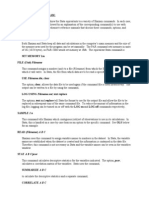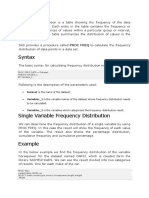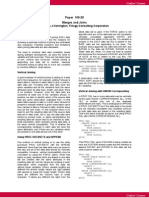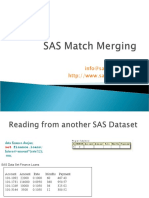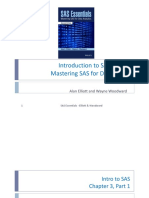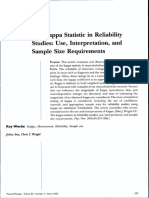0 ratings0% found this document useful (0 votes)
34 viewsC747 Transcripts Part1
C747 Transcripts Part1
Uploaded by
JoseThis document discusses analyzing count and frequency tables using SAS. It covers using PROC FREQ to create one-way and two-way frequency tables, calculating relative risk measures from contingency tables, and using Cohen's kappa to measure inter-rater reliability. Examples are provided to illustrate creating one-way frequency tables from raw or summarized data, testing goodness of fit, and performing a goodness of fit test using Gregor Mendel's pea plant data to test whether it fits a hypothesized 9:3:3:1 ratio.
Copyright:
© All Rights Reserved
Available Formats
Download as PPTX, PDF, TXT or read online from Scribd
C747 Transcripts Part1
C747 Transcripts Part1
Uploaded by
Jose0 ratings0% found this document useful (0 votes)
34 views40 pagesThis document discusses analyzing count and frequency tables using SAS. It covers using PROC FREQ to create one-way and two-way frequency tables, calculating relative risk measures from contingency tables, and using Cohen's kappa to measure inter-rater reliability. Examples are provided to illustrate creating one-way frequency tables from raw or summarized data, testing goodness of fit, and performing a goodness of fit test using Gregor Mendel's pea plant data to test whether it fits a hypothesized 9:3:3:1 ratio.
Original Description:
sas
Copyright
© © All Rights Reserved
Available Formats
PPTX, PDF, TXT or read online from Scribd
Share this document
Did you find this document useful?
Is this content inappropriate?
This document discusses analyzing count and frequency tables using SAS. It covers using PROC FREQ to create one-way and two-way frequency tables, calculating relative risk measures from contingency tables, and using Cohen's kappa to measure inter-rater reliability. Examples are provided to illustrate creating one-way frequency tables from raw or summarized data, testing goodness of fit, and performing a goodness of fit test using Gregor Mendel's pea plant data to test whether it fits a hypothesized 9:3:3:1 ratio.
Copyright:
© All Rights Reserved
Available Formats
Download as PPTX, PDF, TXT or read online from Scribd
Download as pptx, pdf, or txt
0 ratings0% found this document useful (0 votes)
34 views40 pagesC747 Transcripts Part1
C747 Transcripts Part1
Uploaded by
JoseThis document discusses analyzing count and frequency tables using SAS. It covers using PROC FREQ to create one-way and two-way frequency tables, calculating relative risk measures from contingency tables, and using Cohen's kappa to measure inter-rater reliability. Examples are provided to illustrate creating one-way frequency tables from raw or summarized data, testing goodness of fit, and performing a goodness of fit test using Gregor Mendel's pea plant data to test whether it fits a hypothesized 9:3:3:1 ratio.
Copyright:
© All Rights Reserved
Available Formats
Download as PPTX, PDF, TXT or read online from Scribd
Download as pptx, pdf, or txt
You are on page 1of 40
Introduction to SAS Essentials
Mastering SAS for Data Analytics
Alan Elliott and Wayne Woodward
1 SAS ESSENTIALS -- Elliott & Woodward
Chapter 10: ANALYZING COUNTS AND
TABLES
2 SAS ESSENTIALS -- Elliott & Woodward
LEARNING OBJECTIVES
• To be able to use PROC FREQ to create one-way frequency tables
• To be able to use PROC FREQ to create two-way (cross-
tabulation) tables
• To be able to use two-by-two contingency tables to calculate
relative risk measures
• To be able to use Cohen's kappa to calculate inter-rater reliability
3 SAS ESSENTIALS -- Elliott & Woodward
10.1 USING PROC FREQ
PROC FREQ is a multipurpose SAS procedure for analyzing
count data. It can be used to obtain frequency counts for
one or more individual variables or to create two-way
tables (cross-tabulations) from two variables.
A simplified syntax is
PROC FREQ <Options(s)>; <Statements>
TABLES requests </options>;
4 SAS ESSENTIALS -- Elliott & Woodward
Table 10.1. Common Options for PROC FREQ
Option Meaning
DATA=dataname Specify which data set to use
ORDER=option Specifies the order in which results are listed in the output
5 table Options are DATA,
SAS ESSENTIALS FORMATTED,
-- Elliott & Woodward FREQ and ORDER.
This is illustrated in an upcoming example.
PAGE Specifies that only one table will appear per page (not
applicable to HTML output.)
ALPHA=n Sets the level for confidence limits (default 0.05)
COMPRESS Begins the next table on the same page when possible (not
applicable to HTML output.)
NOPRINT Used when you want to capture output but not display
tables.
Table 10.2 Common Statements for PROC FREQ
Option Meaning
EXACT Produces exact p-values for tests. Fisher’s Exact
Test automatically calculated for a 2x2 table.
OUTPUT= dataname Creates an output data set containing statistics
from an analysis
WEIGHT variable Identifies a weight variable that contains
summarized counts
TABLES <variable- Specifies which tables will be displayed. More
combinations/options>; information about this statement is given below.
TEST Specifies which statistical tests will be performed
(Requires a TABLES statement)
BY, FORMAT, LABEL, These statements are common to most
WHERE procedures, and may be used here.
6 SAS ESSENTIALS -- Elliott & Woodward
The TABLES Statement
The TABLES statement is required for all of the examples
in this chapter. Its format is:
TABLES <variable-combinations/options>;
where variable-combinations specifies frequency or
cross-tabulation tables. Options for the TABLE statement
follow a slash (/). For example,
TABLES A*B / CHISQ;
requests that the chi-square and related statistics will be
reported for the cross-tabulation A*B.
7 SAS ESSENTIALS -- Elliott & Woodward
More about TABLES
To obtain counts of the number of subjects observed in each
category of group (GP), use the following:
PROC FREQ; TABLES GP; RUN;
To produce a cross-tabulation of GENDER by treatment GP:
PROC FREQ; TABLES GENDER*GP;RUN;
The variables specified in the TABLES statement can be either
categorical/character or numeric.
To request chi-square statistics for a table, include the option
/CHISQ at the end of the TABLES statement. For example,
PROC FREQ; TABLES GENDER*GP/CHISQ;
8 SAS ESSENTIALS -- Elliott & Woodward
Table 10.3. Sample TABLES statements
Table Specification Description
TABLES A; Specifies frequencies for a single variable
TABLES A*B; Specifies a crosstabulation between two variables
TABLES A*B B*C X*Y; Also,
TABLES A*(B C D);
Specify several cross-tabulation tables
is the same as
TABLES A*B A*C A*D;
TABLES (A -- C)*X;
is the same as Use a range of variables in a TABLES statement
TABLES A*X B*X C*X;
9 SAS ESSENTIALS -- Elliott & Woodward
TABLE 10.4 Options for the TABLE Statement
Option Description
AGREE Request Kappa statistic (inter-rater reliability).
RELRISK Requests relative risk calculations
FISHER Requests Fisher’s Exact test for tables greater than 2 x 2
SPARSE Requests all possible combinations of levels
MISSING Requests missing values treated as nonmissing
CELLCHI2 Displays the contribution to chi-square
NOCOL Suppresses column percentages for each cell
NOCUM Suppresses cumulative frequencies
NOFREQ Suppresses frequency count for each cell
NOPERCENT Suppresses row percentage and column percentage in cross-
tabulation tables
NOPRINT Suppresses tables but displays statistics
NOROW Suppresses row percentage for each cell
TESTP=(list) Specifies a test based on percentages (Goodness-of-Fit
test.)
10 SAS ESSENTIALS -- Elliott & Woodward
10.2 ANALYZING ONE-WAY FREQUENCY TABLES
When count data are collected, you can use PROC FREQ
to produce tables of the counts by category as well as to
perform statistical analyses on the counts.
This section describes how to create tables of counts by
category and how to perform a goodness-of-fit test.
Do Hands On Example p 246 (AFREQ1.SAS) (Frequencies)
11 SAS ESSENTIALS -- Elliott & Woodward
ORDER= Option
The ORDER=FORMATTED option for PROC FREQ specifies
the order in which the categories are displayed in the
table.
You must first create a custom format in a PROC FORMAT
command to define the order that you want to be used in
your output table. For Example:
PROC FORMAT;
VALUE $FMTRACE "AA"="African American"
"H"="Hispanic"
"OTH"="Other "
"C"="White";
RUN;
12 SAS ESSENTIALS -- Elliott & Woodward
Apply Your Created Format
To cause PROC FREQ to display categories in the Formatted
order, apply your created FORMAT:
The ORDER= option species the order in
which the categories are displayed. In this
case, they are displayed in FORMATTED
order.
PROC FREQ ORDER= FORMATTED
DATA=" C: \SASDATA \SURVEY";
TABLES RACE;
FORMAT RACE $FMTRACE.; You must also apply the
RUN; format to the variable for
it to be correctly used.
Do Hands On Exercise p 248. (AFREQ2.SAS)
13 SAS ESSENTIALS -- Elliott & Woodward
10.3 CREATING ONE-WAY FREQUENCY TABLFS FROM
SUMMARIZED DATA
The following example illustrates how to summarize counts
from a data set into a frequency table
Suppose your data is in this summarized form:
CENTS 152
CENTS 100
This means there are 49
NICKELS 49 nickels
DIMES 59
QUARTERS 21
HALF 44
DOLLARS 21
Do the Hands On Exercise p 250 (AFREQ3.SAS)
14 SAS ESSENTIALS -- Elliott & Woodward
Testing Goodness of Fit in a One-Way Table
A goodness-of-fit test of a single population is a test to
determine if the distribution of observed frequencies in
the sample data closely matches with the expected
number of occurrences under a hypothetical distribution
for the population.
The hypotheses being tested are as follows:
H0: The population follows the hypothesized distribution.
Ha : The population does not follow the hypothesized
distribution.
15 SAS ESSENTIALS -- Elliott & Woodward
Goodness-of-fit using PROC FREQ
A chi-square statistic is calculated, and a decision can be
made based on the p-value associated with that statistic.
A low p-value indicates that the data do not follow the
hypothesized, or theoretical, distribution. If the p-value is
sufficiently low (usually <0.05), you will reject the null
hypothesis. The syntax to perform a goodness-of-fit test is
as follows:
PROC FREQ; TABLES variable/ CHISQ
TESTP=(list of ratios);
16 SAS ESSENTIALS -- Elliott & Woodward
Goodness-of-fit Example
As an example, we will use data from an experiment
conducted by the nineteenth-century monk Gregor
Mendel. According to a genetic theory, crossbred pea
plants show a 9:3:3:1 ratio. From 556 plants, you expect
(9/16) x 556 = 312.75 yellow smooth peas (56.25%)
(3/16) x 556 = 104.25 yellow wrinkled peas (18.75%)
(3/16) x 556 = 104.25 green smooth peas (18.75%)
(1/16) x 556 = 34.75 green wrinkled peas (6.25%)
17 SAS ESSENTIALS -- Elliott & Woodward
Actual Observed Data
After growing 556 of these pea plants, Mendel observed
the following:
315 have yellow smooth peas
108 have yellow wrinkled peas
101 have green smooth peas
32 have green wrinkled peas
18 SAS ESSENTIALS -- Elliott & Woodward
The Goodness-of-Fit Code
Hypothesizing a 9:3:3 :1 Ratio:
PROC FREQ ORDER=DATA ; WEIGHT NUMBER;
TITLE 'GOODNESS OF FIT ANALYSIS';
TABLES COLORTYPE / NOCUM CHISQ
TESTP=(0.5625 0.1875 0.1875 0.0625);
RUN;
Note these proportions are in a 9:3:3:1 ratio
Do Hands on Example p 252 (AFRE4.SAS)
19 SAS ESSENTIALS -- Elliott & Woodward
10.4 ANALYZING TWO-WAY TABLES
To create a cross-tabulation table using PROC FREQ for
relating two variables, use the TABLES statement with
both variables listed and separated by an asterisk (*),
(e.g., A*B).
A cross-tabulation table is formed by counting the
number of occurrences in a sample across two grouping
variables.
The number of columns in a table is usually denoted by c
and the number of rows by r. Thus, a table is said to be an
r x c table, that is, it has r x c cells.
20 SAS ESSENTIALS -- Elliott & Woodward
Test of Independence
The hypotheses associated with a test of independence
are as follows:
H0: The variables are independent (no association between
them).
Ha : The variables are not independent.
For example, a null hypothesis could
be that there is no association
between handedness (left and right
handed) to hair color
21 SAS ESSENTIALS -- Elliott & Woodward
Test of Homogeneity
The null hypothesis is that the populations have the same
distribution (they are homogeneous). In this case, the
hypotheses are as follows:
H0: The populations are homogeneous.
Ha : The populations are not homogeneous.
For example, a null hypothesis could be that
from two populations, (male and female) the
distribution of handedness the same.
22 SAS ESSENTIALS -- Elliott & Woodward
Testing These Hypotheses
The chi-square test of independence or homogeneity is
reported by PROC FREQ (the tests are mathematically
equivalent) by the use of the I CHISQ option in the
TABLES statement. Use the same code to test for
For example, either independence or
homogeneity
PROC FREQ; TABLES GENDER*GP/ CHISQ;
Do Hands On Exercise p 254. (AFREQ5.SAS)
23 SAS ESSENTIALS -- Elliott & Woodward
Example code to perform a Chi-Square Test on an rx c
contingency table (Crime Example)
Note that WEIGHT COUNT; is needed
since the data are in summary form.
PROC FREQ DATA=DRINKERS; WEIGHT COUNT;
TABLES CRIME*DRINKER/CHISQ;
TITLE 'Chi Square Analysis of a
Contingency Table';
RUN;
24 SAS ESSENTIALS -- Elliott & Woodward
Summarized Data for the Crime Case
CRIME DRINKER COUNT
Arson 1 50
Arson 0 43 Notice how the data are in
Rape 1 88 summarized for. For Arson,
there were 50 “Drinkers”
Rape 0 62 (DRINKER=1) and 43 “Non-
Violence 1 155 Drinkers) (DRINKER=0)
Violence 0 110
Stealing 1 379
Stealing 0 300
Coining 1 18
Coining 0 14
Fraud 1 63
Fraud 0 144
25 SAS ESSENTIALS -- Elliott & Woodward
Results of Chi Square Analysis
Observe the statistics
table. The Chi-Ssquare
value is 49.73 and the p-
value is p < 0.0001.
Thus, you reject the null
hypothesis of no
association
(independence) and
conclude that there is
evidence of a
relationship between
drinking status and type
of crime committed.
26 SAS ESSENTIALS -- Elliott & Woodward
Creating a Contingency Table from Raw Data, the 2 x
2 Case
In the previous example (CRIME) the data were in
summary form, and you needed to use the WEIGHT
COUNT; statement to reflect that.
If your data are in raw form – one record per observation,
you do not need the WEIGHT statement.
For this data, each subject
has one record – thus you
have one record per
observation.
Do Hands on Example p 257 (AFREQ6.SAS)
27 SAS ESSENTIALS -- Elliott & Woodward
Output from 2x2 Chi-Square Analysis
Statistical Results – note in particular
The Resulting Table of counts: the Chi-Square and Fisher Two-Sided
Pr<=p values.
The chi-square statistic, 8.29, p = 0.004,
indicates an association between
CLEANER and RASH (rejects the null
hypothesis). The two-sided Fisher results
p = 0.0095 provides the same decision.
28 SAS ESSENTIALS -- Elliott & Woodward
Tables with Small Counts in Cells
When you summarize counts in tables, and there are
small numbers in one or more cells, a typical chi-square
statistical analysis may not be valid.
Do Hands On Example p 259 (AFREQ7.SAS)
Observe the warning message "WARNlNG: 50% of the
cells have expected counts <5. Chi-square may not be a
valid test.“
In this case, the Fisher's Exact test (given in Table 10.13) is
the more reliable test and should be used instead of the
Chi-Square test.
29 SAS ESSENTIALS -- Elliott & Woodward
10.5 GOING DEEPER: CALCULATING RELATIVE RISK
MEASURES
Two-by-two contingency tables are often used when
examining a measure of risk.
A measure of this risk in a retrospective (case-control)
study is called the odds ratio (OR). In a case- control
study, a researcher takes a sample of subjects and looks
back in time for exposure (or nonexposure).
If the data are collected prospectively, where subjects are
selected by presence or absence of a risk and then
observed over time to see if they develop an outcome,
the measure of risk is called relative risk (RR).
Either way RR=1 or OR=1 means no risk observed.
30 SAS ESSENTIALS -- Elliott & Woodward
Testing Relative Risk in PROC FREQ
In PROC FREQ, the option to calculate the values for OR
or RR is RELRISK and appears as an option to the TABLES
statement as shown here (for the RASH data):
TABLES CLEANER*RASH /RELRISK;
In the results, a risk measure > 1 indicates that exposure
is harmful and a risk measure <1 implies that exposure is
a benefit.
Do Hands On Example p 261 (AFREQ6.SAS)
31 SAS ESSENTIALS -- Elliott & Woodward
The OR= 0.1346 specifies the odds of
Results of Risk Analysis Row1/Row2 - that is, for cleaner 1
versus cleaner 2. Because OR is <1,
this indicates that the odds of a
Typically, the Odds Ratio is the person's having a rash who is using
statistic of interest cleaner 1 is less than they are when
the person is using cleaner 2.
32 SAS ESSENTIALS -- Elliott & Woodward
10.6 GOING DEEPER: INTER-RATER RELIABILITY (KAPPA)
A method for assessing the degree of agreement between
two raters is Cohen's kappa coefficient.
For example, kappa is useful for analyzing the consistency
of two raters who evaluate subjects on the basis of a
categorical measurement. Two Raters A and B compared…
Data for inter-rater reliability analysis
RATER A
Psyc. Neuro. Organic
Psych. 75 1 4
Neuro. 5 4 1
Rater B
Organic. 0 0 10
80 5 15
33 SAS ESSENTIALS -- Elliott & Woodward
Code used to Calculate Kappa
These options provide the
PROC FREQ Kappa test results.
WEIGHT WT;
TABLE RATERl*RATER2 / AGREE ;
TEST KAPPA;
TITLE 'KAPPA EXAMPLE FROM FLEISS';
RUN;
Do Hands on Exercise p 262 (AKAPPA1.SAS)
34 SAS ESSENTIALS -- Elliott & Woodward
Results of Kappa Analysis
This is Kappa – the primary
statistic of interest
How to interpret kappa.
Interpretation of kappa statistic
Kappa Value Interpretation
<0 No agreement
0.0–0.20 Poor agreement
0.21–0.40 Fair agreement
0.41–0.60 Moderate agreement
0.61–0.80 Substantial agreement
See text for additional explanation
of these results. 0.81–1.00 Almost perfect agreement
35 SAS ESSENTIALS -- Elliott & Woodward
Calculating Weighted Kappa
For the case in which rated categories are ordinal (that is
the categories of interest are in a meaningful order), it is
appropriate to use the weighted kappa statistic, because
it is designed to give partial credit to ratings that are close
to but not on the diagonal.
For example, in a test of recognition of potentially
dangerous airline passengers, suppose a procedure is
devised that classifies passengers into three categories:
1 =No threat/Pass Note how these 3 categories are
ascending in danger – they have
2 =Concern/Recheck a definite order (they are
ordinal.)
3 =Potential threat/Detain.
Do Hands on Exercise p 265 (AKAPPA2.SAS)
36 SAS ESSENTIALS -- Elliott & Woodward
Weighted Kappa Results
The code uses this code to caclulate
the weighted kappa:
TABLE RATER1*RATER2 /AGREE;
TEST WTKAP;
For this analysis report the
“Weighted Kappa” value
kappa=0.7413.
Use the same interpretation of
kappa table as before.
See text for the interpretation of
other results.
37 SAS ESSENTIALS -- Elliott & Woodward
10.7 SUMMARY
This chapter discusses the capabilities of PROC FREQ for
creating one- and two-way frequency tables, analyzing
contingency tables, calculating measures of risk, and
measuring inter-rater reliability (using KAPPA).
Continue to Chapter 11: COMPARING MEANS USING T-
TESTS
38 SAS ESSENTIALS -- Elliott & Woodward
39 SAS ESSENTIALS -- Elliott & Woodward
40 SAS ESSENTIALS -- Elliott & Woodward
You might also like
- 101 Blue Ribbon Dessert Recipes PDFDocument114 pages101 Blue Ribbon Dessert Recipes PDFJose100% (6)
- Advanced SAS 9 ExamPrep SritejGuntaDocument60 pagesAdvanced SAS 9 ExamPrep SritejGuntasriteja100% (3)
- Sas Handbook: By: Luis MontesDocument20 pagesSas Handbook: By: Luis Monteslmontes93No ratings yet
- C747 Transcripts Part1Document224 pagesC747 Transcripts Part1Jose0% (1)
- Module Summary: Analyzing and Reporting On Data: Enhancing Reports With Titles, Footnotes, and LabelsDocument2 pagesModule Summary: Analyzing and Reporting On Data: Enhancing Reports With Titles, Footnotes, and LabelsjefinNo ratings yet
- SAS ProceduresDocument8 pagesSAS Proceduresrpkn541No ratings yet
- Stem-and-Leaf Plots Frequencies Tables Frequency ChartsDocument7 pagesStem-and-Leaf Plots Frequencies Tables Frequency ChartsBabish ShresthaNo ratings yet
- W3 Syntax ReviewDocument4 pagesW3 Syntax ReviewCansu YöreoğluNo ratings yet
- Sas Tutorial ProcunivariateDocument10 pagesSas Tutorial Procunivariatewilliamsa01No ratings yet
- TabulateDocument23 pagesTabulateJoanne WongNo ratings yet
- Unit Iii Sas ProceduresDocument27 pagesUnit Iii Sas ProceduresDivya JijuNo ratings yet
- Introduction To Tables and Graphs in SASDocument8 pagesIntroduction To Tables and Graphs in SASpravin sNo ratings yet
- Sas Week3 Summary - ExploreDocument4 pagesSas Week3 Summary - ExplorejefinNo ratings yet
- Proc SQL SubqueryDocument10 pagesProc SQL SubqueryDebaraj SarkarNo ratings yet
- PLSQLDocument14 pagesPLSQLNagarjuna Rao KhamithkarNo ratings yet
- ODS Output StatementDocument13 pagesODS Output StatementVarun NakraNo ratings yet
- SAS Introduction To Time Series Forecasting-LibreDocument34 pagesSAS Introduction To Time Series Forecasting-LibrepalaniNo ratings yet
- SAS Info 2Document4 pagesSAS Info 2Ieu KusNo ratings yet
- Descriptive Statistics Using SASDocument10 pagesDescriptive Statistics Using SASsxurdcNo ratings yet
- Tips and Tricks of SAS With Sample CodeDocument21 pagesTips and Tricks of SAS With Sample CodeAl-YahyaiNo ratings yet
- Percentages Using Proc TabulateDocument11 pagesPercentages Using Proc Tabulatevam_1No ratings yet
- Shazam To StataDocument4 pagesShazam To StataFrank FromhereNo ratings yet
- Frequency DistributionDocument4 pagesFrequency DistributionprakashNo ratings yet
- R Exercises 3 PDFDocument91 pagesR Exercises 3 PDFSoumi BanerjeeNo ratings yet
- Proc - CompareDocument7 pagesProc - ComparenaveenNo ratings yet
- Import Xls Sas CodeDocument6 pagesImport Xls Sas CodeNik KumarNo ratings yet
- SAS Notes Part 7Document8 pagesSAS Notes Part 7Nicole WardNo ratings yet
- Sas InterviewDocument12 pagesSas InterviewSiva NunnaNo ratings yet
- Lab 1 Introduction To DataDocument11 pagesLab 1 Introduction To DatadushyantkrNo ratings yet
- Expression Set IntroductionDocument11 pagesExpression Set Introductionnikunj joshiNo ratings yet
- Chapter 6, "Automatic Performance Diagnostics"Document7 pagesChapter 6, "Automatic Performance Diagnostics"shubhrobhattacharyaNo ratings yet
- R Code For Linear Regression Analysis 1 Way ANOVADocument8 pagesR Code For Linear Regression Analysis 1 Way ANOVAHagos TsegayNo ratings yet
- Stata Time Series VarsocDocument6 pagesStata Time Series Varsocaiwen_wong2428No ratings yet
- Clinical Trial Reporting Using SASGRAPHDocument21 pagesClinical Trial Reporting Using SASGRAPHnathi_nathiNo ratings yet
- Very Good Examples SAS Before InterviewDocument22 pagesVery Good Examples SAS Before InterviewMrigank TayalNo ratings yet
- Paper 109-25 Merges and Joins: Timothy J Harrington, Trilogy Consulting CorporationDocument6 pagesPaper 109-25 Merges and Joins: Timothy J Harrington, Trilogy Consulting CorporationJb ReddyNo ratings yet
- MySQL QueryDocument18 pagesMySQL QueryTR SunnyNo ratings yet
- My-Sql: Learning ObjectivesDocument22 pagesMy-Sql: Learning ObjectivesHarshit PandeyNo ratings yet
- Proc TabulateDocument17 pagesProc TabulateDIARRANo ratings yet
- Teradata E2Document12 pagesTeradata E2Teakadai ProductionsNo ratings yet
- 4 Creating List ReportsDocument12 pages4 Creating List ReportsKentNo ratings yet
- SQL Commands and SyntaxDocument5 pagesSQL Commands and SyntaxNathNo ratings yet
- SAS Slides 7: Match Merging With DatastepDocument22 pagesSAS Slides 7: Match Merging With DatastepSASTechiesNo ratings yet
- Proc SQLDocument7 pagesProc SQLhima100% (1)
- Interview QuestionsDocument2 pagesInterview QuestionsMaketz BonoNo ratings yet
- List of SQL CommandsDocument18 pagesList of SQL CommandsSuraj BachhavNo ratings yet
- Stat A IntroDocument19 pagesStat A IntroBarbaraMondaNo ratings yet
- Introduction To STATADocument57 pagesIntroduction To STATATETY FREJUS BEUGRENo ratings yet
- Escriptive Tatistics ND Tabulation: Pavan Kumar ADocument25 pagesEscriptive Tatistics ND Tabulation: Pavan Kumar Anaresh darapuNo ratings yet
- Lab 3 - Kristi Proc UnivariateDocument10 pagesLab 3 - Kristi Proc UnivariateJacob SheridanNo ratings yet
- SELECT With Various Clause - WHERE, Pattern MatchingDocument4 pagesSELECT With Various Clause - WHERE, Pattern Matchingmahima 008No ratings yet
- Website Development Lecture 11 by Ahmed Al AzaweiDocument4 pagesWebsite Development Lecture 11 by Ahmed Al AzaweiRola OwadhNo ratings yet
- Aditya Garg DMDWDocument40 pagesAditya Garg DMDWRaj NishNo ratings yet
- Lab10 Augmented LatticeDocument5 pagesLab10 Augmented LatticeItalo GranatoNo ratings yet
- Excel Cheat Sheet Accumulated by Aashi ParekhDocument7 pagesExcel Cheat Sheet Accumulated by Aashi Parekhscpkaiser11No ratings yet
- Relational Database Management Systems For EpidemiologistsDocument51 pagesRelational Database Management Systems For Epidemiologistsksvp852692No ratings yet
- Lecture 1 Overview: Two Things in BackendDocument21 pagesLecture 1 Overview: Two Things in Backendwec11011No ratings yet
- MergeDocument16 pagesMergeArijit Das0% (1)
- Tata SASDocument285 pagesTata SASc4shivaNo ratings yet
- Advanced SAS Interview Questions You'll Most Likely Be AskedFrom EverandAdvanced SAS Interview Questions You'll Most Likely Be AskedNo ratings yet
- Organic Sweets and Treats - More Than 70 Delicious Recipes PDFDocument148 pagesOrganic Sweets and Treats - More Than 70 Delicious Recipes PDFJose100% (2)
- Hag Hasukkkot or Hag Lashem An Analysis of The Parashat Hamoadot Vayyikra 23 The Torah Reading For The First Days of SukkotDocument12 pagesHag Hasukkkot or Hag Lashem An Analysis of The Parashat Hamoadot Vayyikra 23 The Torah Reading For The First Days of SukkotJoseNo ratings yet
- Chapter 8 SAS ESSENTIALSDocument48 pagesChapter 8 SAS ESSENTIALSJoseNo ratings yet
- Chapter 3 SAS ESSENTIALSDocument50 pagesChapter 3 SAS ESSENTIALSJoseNo ratings yet
- C747 Transcripts Part2Document159 pagesC747 Transcripts Part2JoseNo ratings yet
- C747 Transcripts Part2Document159 pagesC747 Transcripts Part2JoseNo ratings yet
- Statistical Methods For Psychology 8th Edition Howell Solutions Manual 1Document21 pagesStatistical Methods For Psychology 8th Edition Howell Solutions Manual 1peter100% (65)
- 07 ML Classificaion Advanced KappaDocument18 pages07 ML Classificaion Advanced KappaIn TechNo ratings yet
- Kappa StatsDocument6 pagesKappa StatsJuank Z BkNo ratings yet
- Indo PeatlandDocument17 pagesIndo PeatlandIsmorel IsmorelNo ratings yet
- Revisiting The Theoretical and Methodological Foundations of Depression MeasurementDocument11 pagesRevisiting The Theoretical and Methodological Foundations of Depression MeasurementBernar GonzálezNo ratings yet
- Journal of Land Management and Geomatics Education Volume 3Document66 pagesJournal of Land Management and Geomatics Education Volume 3Tri Dev AcharyaNo ratings yet
- Analysis of Dream Contents by Scaled and Rated Measurements: Jean-Michel Gaillard and Marc PhelippeauDocument8 pagesAnalysis of Dream Contents by Scaled and Rated Measurements: Jean-Michel Gaillard and Marc PhelippeauFederico TorresNo ratings yet
- Understanding Body Movement Author Hedda LausbergDocument363 pagesUnderstanding Body Movement Author Hedda LausbergBagel DeliveryNo ratings yet
- Leveraging Moya, Whatsapp and Online Discussion Forum To Support Students at An Open and Distance E-Learning UniversityDocument22 pagesLeveraging Moya, Whatsapp and Online Discussion Forum To Support Students at An Open and Distance E-Learning Universitybuat meetingNo ratings yet
- Content Analysis: Method, Applications, and Issues: Health Care For Women InternationalDocument10 pagesContent Analysis: Method, Applications, and Issues: Health Care For Women InternationalLenin GuerraNo ratings yet
- IJC-23-1360 Proof HiDocument37 pagesIJC-23-1360 Proof HiMohammad HeidariNo ratings yet
- Qualitative Data Management and Analysis Using Nvivo: An Approach Used To Examine Leadership Qualities Among Student LeadersDocument10 pagesQualitative Data Management and Analysis Using Nvivo: An Approach Used To Examine Leadership Qualities Among Student Leaderssanthiya perisamyNo ratings yet
- Kappa Test For Agreement Between Two RatersDocument12 pagesKappa Test For Agreement Between Two RatersscjofyWFawlroa2r06YFVabfbajNo ratings yet
- Landis 1977 KappaDocument17 pagesLandis 1977 KappaseleneNo ratings yet
- Montiel 2014Document28 pagesMontiel 2014daoh782No ratings yet
- 17D17 470 Icha PCM Mochamad Fahlevi Rizal Annisa R AmaliaDocument11 pages17D17 470 Icha PCM Mochamad Fahlevi Rizal Annisa R AmaliafadelmsNo ratings yet
- Inter - and Intra-Rater Reliability of The B Lindmark Motor Assessment.Document6 pagesInter - and Intra-Rater Reliability of The B Lindmark Motor Assessment.Raluca HereaNo ratings yet
- Validitas Isi: Tahap Awal Pengembangan KuesionerDocument11 pagesValiditas Isi: Tahap Awal Pengembangan KuesionerSuryanti ChenNo ratings yet
- Miguel y Cristina-Multitemporal Analysis.... (2019)Document13 pagesMiguel y Cristina-Multitemporal Analysis.... (2019)Cristina Mercedes Oclocho AltamiranoNo ratings yet
- The Kappa Statistic in Reliability Studies - Use, Interpretation, and Sample Size Requirements - Sim & Wright (2005) PDFDocument13 pagesThe Kappa Statistic in Reliability Studies - Use, Interpretation, and Sample Size Requirements - Sim & Wright (2005) PDFEduardo Aguirre Dávila100% (1)
- Mini Research ICT Ok 2017 Ok GRUPDocument105 pagesMini Research ICT Ok 2017 Ok GRUPKang AweyNo ratings yet
- Wild Animal Species Classification From Camera Traps Using Metadata AnalysisDocument6 pagesWild Animal Species Classification From Camera Traps Using Metadata Analysismohib.elpsimNo ratings yet
- The Effects of Check-In Check-Out On Problem Behavior and Academic Skills in Elementary SchoolsDocument11 pagesThe Effects of Check-In Check-Out On Problem Behavior and Academic Skills in Elementary SchoolsKierraNo ratings yet
- Part 16 PDFDocument7 pagesPart 16 PDFKarolina PolskaNo ratings yet
- Weinberger Fischer 2006Document56 pagesWeinberger Fischer 2006inyas inyasNo ratings yet
- duttasurajit34gmailcomCLASSIFICATION OF ACCURACY ASSESSMENT2Document8 pagesduttasurajit34gmailcomCLASSIFICATION OF ACCURACY ASSESSMENT2THIRSHATH VNo ratings yet
- (Artigo) Landis e Koch 1977 Intervalo Kappa The Measurement of Observer Agreement Categorical DataDocument17 pages(Artigo) Landis e Koch 1977 Intervalo Kappa The Measurement of Observer Agreement Categorical DataJkhdsjkhjh JknjkhnjhNo ratings yet
- Monitoring Affective Trajectories During Complex LearningDocument6 pagesMonitoring Affective Trajectories During Complex LearningInês SousaNo ratings yet
- Nostalgia 1: Nostalgia: Content, Triggers, FunctionsDocument59 pagesNostalgia 1: Nostalgia: Content, Triggers, FunctionsNatula Tula100% (1)
- Gender Stereotyping of Parents RepresntationDocument7 pagesGender Stereotyping of Parents Represntationsmart_eng2009No ratings yet





















